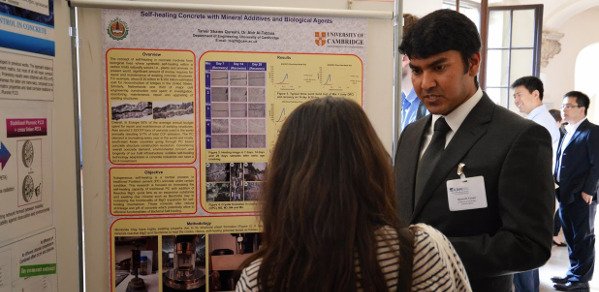
Tanvir Qureshi, a first year PhD student in civil engineering, was the proud recipient of the 'Wiley Poster Award' at the 4th International Conference on Self-Healing Materials, for the best poster in the Construction Materials category.
I was very surprised to receive this award as I am only a first year PhD student, but was of course extremely delighted and felt incredibly privileged to win this as a recognition by the internationally leading academic panel of my initial hard work in this new field and my clear enthusiasm for the subject. I stood by my poster answering questions from the panel and conference delegates and was delighted to hear really encouraging and positive comments.
Tanvir Qureshi
Tanvir is a PhD student in the Geotechnical and Environmental Group and is supervised by Dr Abir Al-Tabbaa. His poster was entitled 'Self-healing concrete with mineral additives and biological agents'. Tanvir is part of a team who are working on the development of self-healing construction materials which was recently awarded EPSRC funding through the Materials for Life project.
Significant funding is being spent on the repair and maintenance of existing concrete structures. In the United States, about $20 to $200 billion is spent on reconstruction of bridges. Similarly, in the UK, over 45% of annual expenditure on construction is spent on repair and maintenance. In addition, ~2.3 billion tonnes of cement are used throughout the world annually resulting in 5-7% of total CO2 emission. Despite this, there is considerable and growing demand for concrete given the construction revolution we are witnessing in Asia. These demands, environmental concerns and significant costs of the maintenance of our ageing infrastructure, have been catalysts in the emergence of the concept of self-healing concrete.
There are a number of self-healing concepts for concrete that are being researched. Tanvir's PhD research focuses specifically on the use of a combined system of expansive mineral additives, e.g. magnesia, lime and bentonite, and carbonate precipitating bacteria. Tanvir explains, that while those two systems have been investigated separately, this is the first time they are being considered together. The idea is that they will both facilitate healing at different length scales complementing each other. In addition, the use of magnesia as a mineral additive has not been used before and is expected to lead to a lower pH cement, which will provide a far less aggressive environment for the bacteria to survive in. In addition the precipitation of magnesium carbonates by the bacteria, rather than calcium carbonate will provide significantly enhanced strength of the self-healed zones.
Tanvir holds a faculty position in the Department of Civil Engineering, Leading University, Sylhet, Bangladesh, from which he has taken leave to study for his PhD, which is being funded by the Islamic Development Bank.

